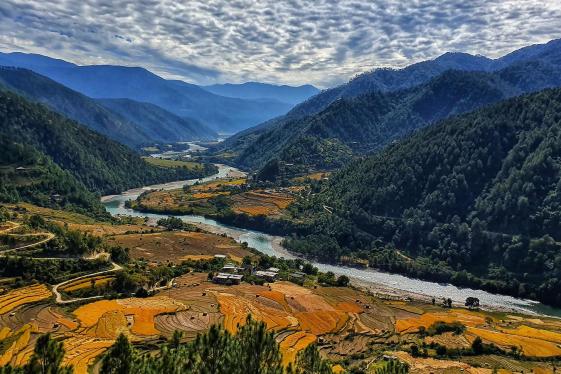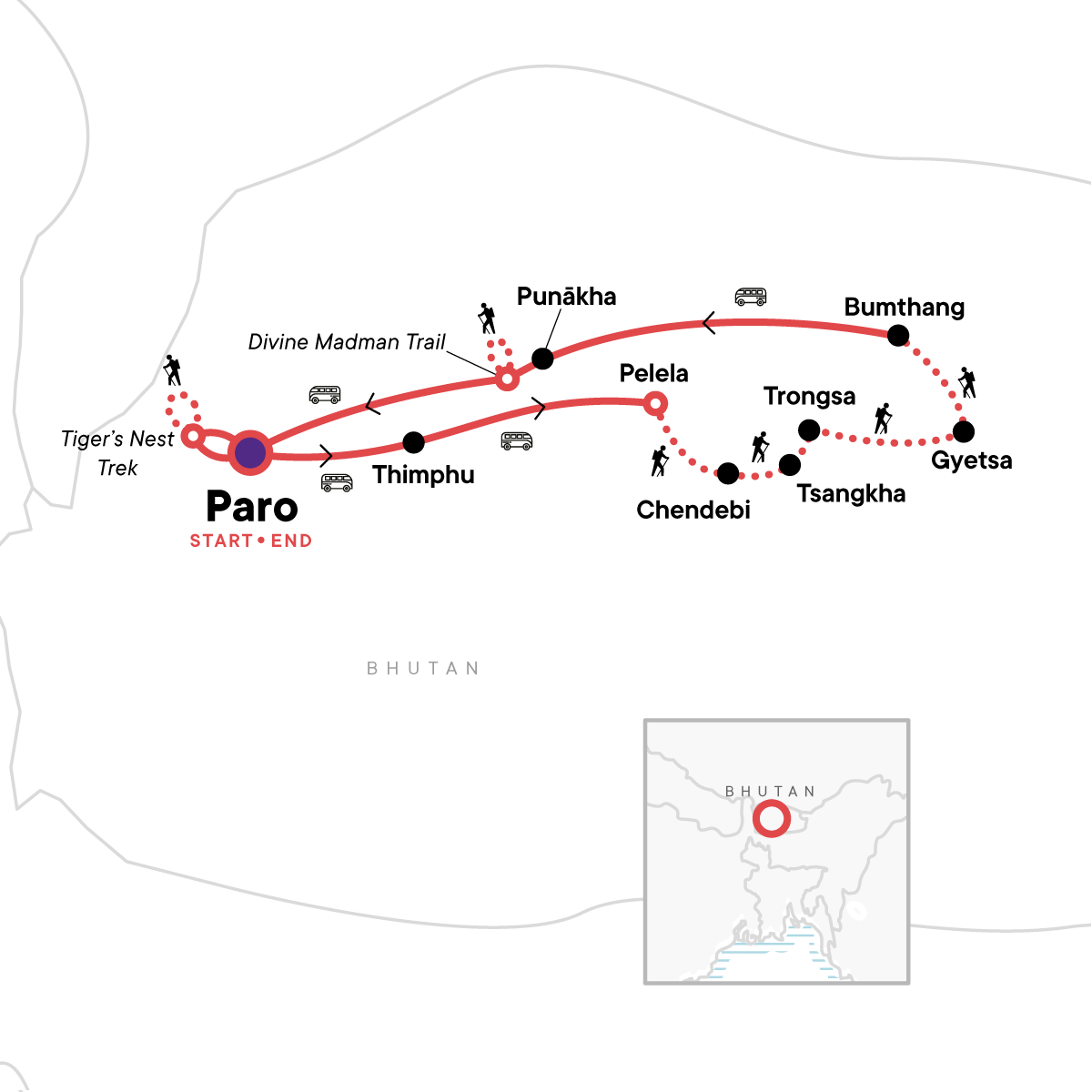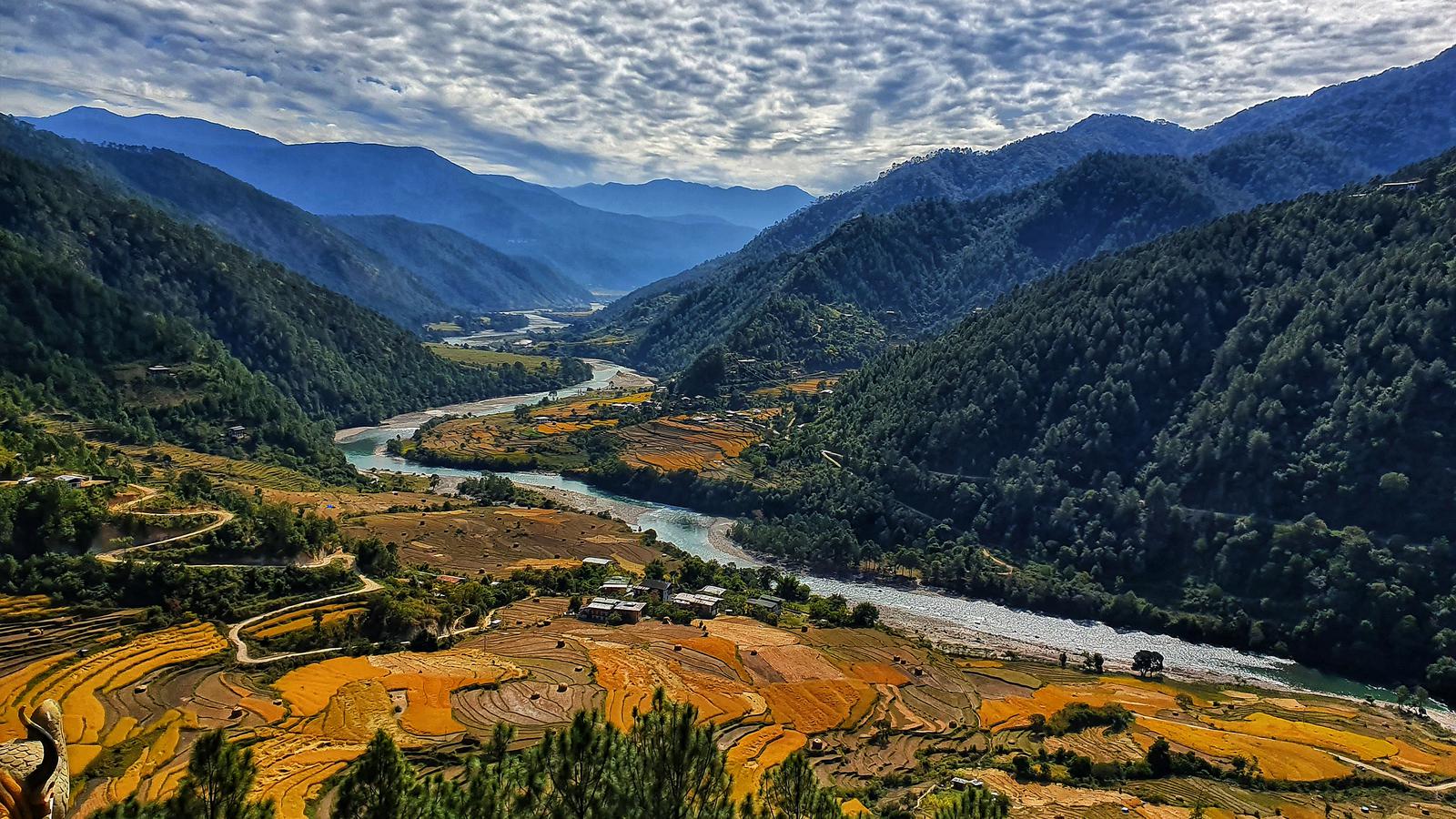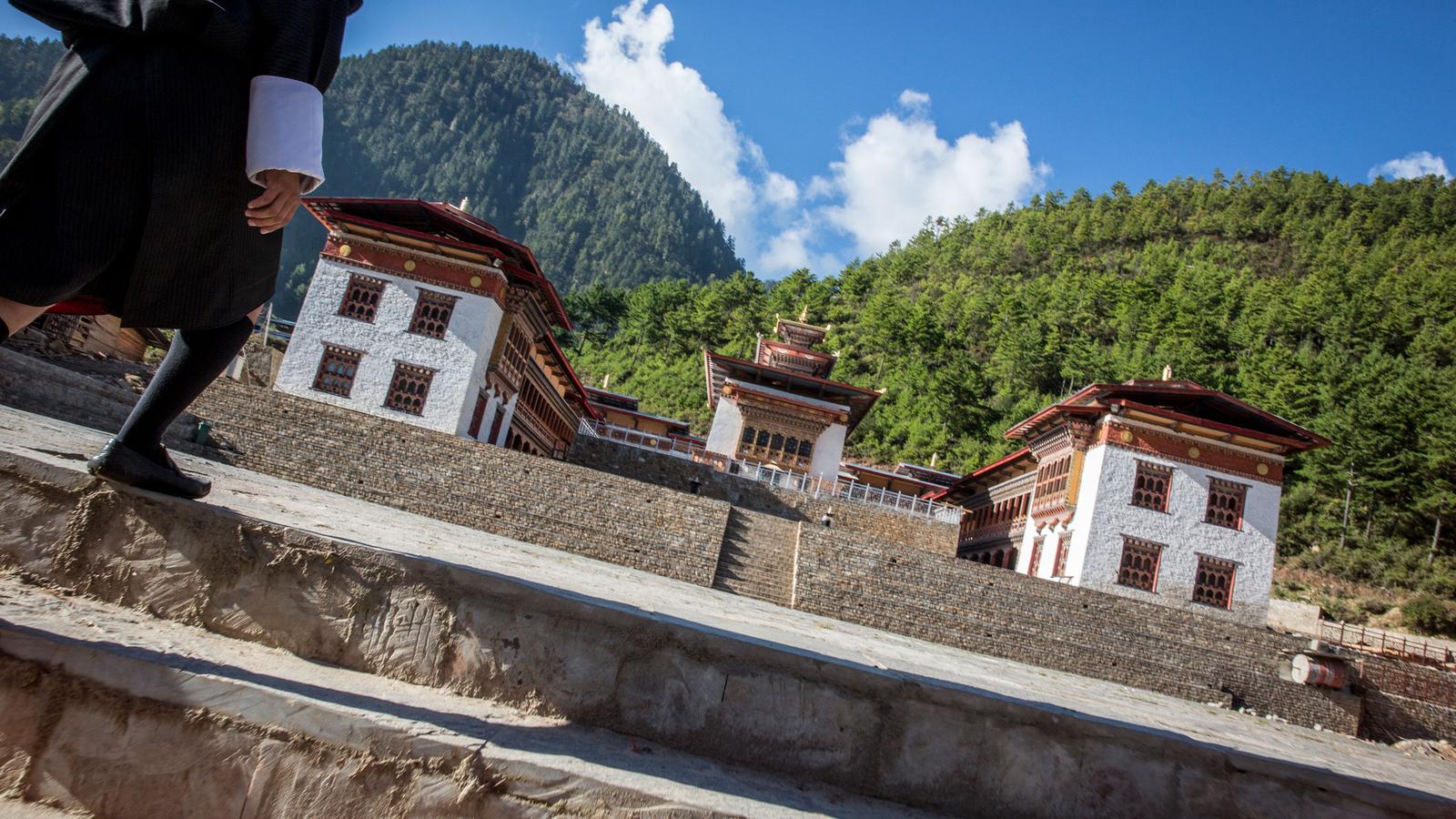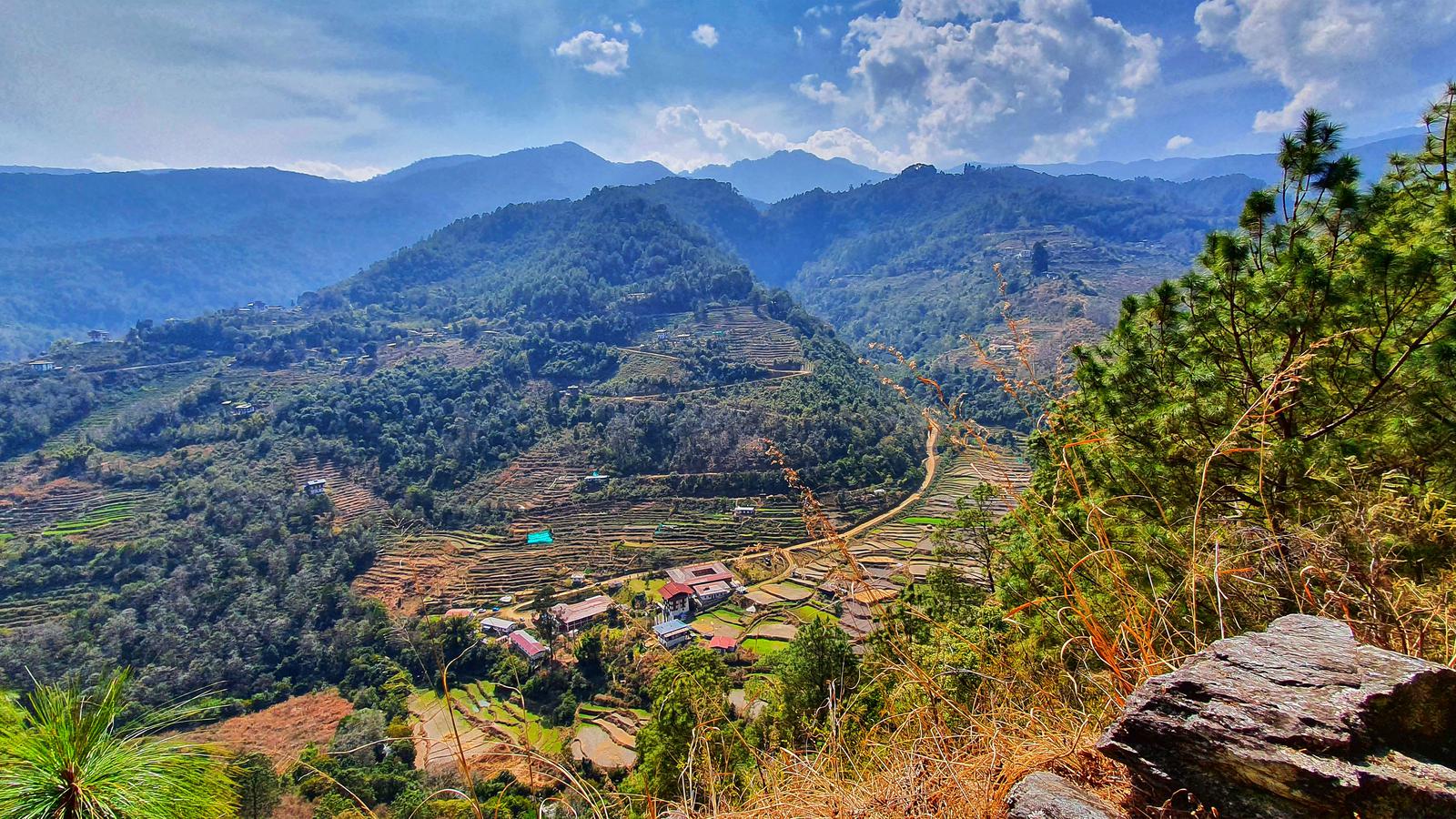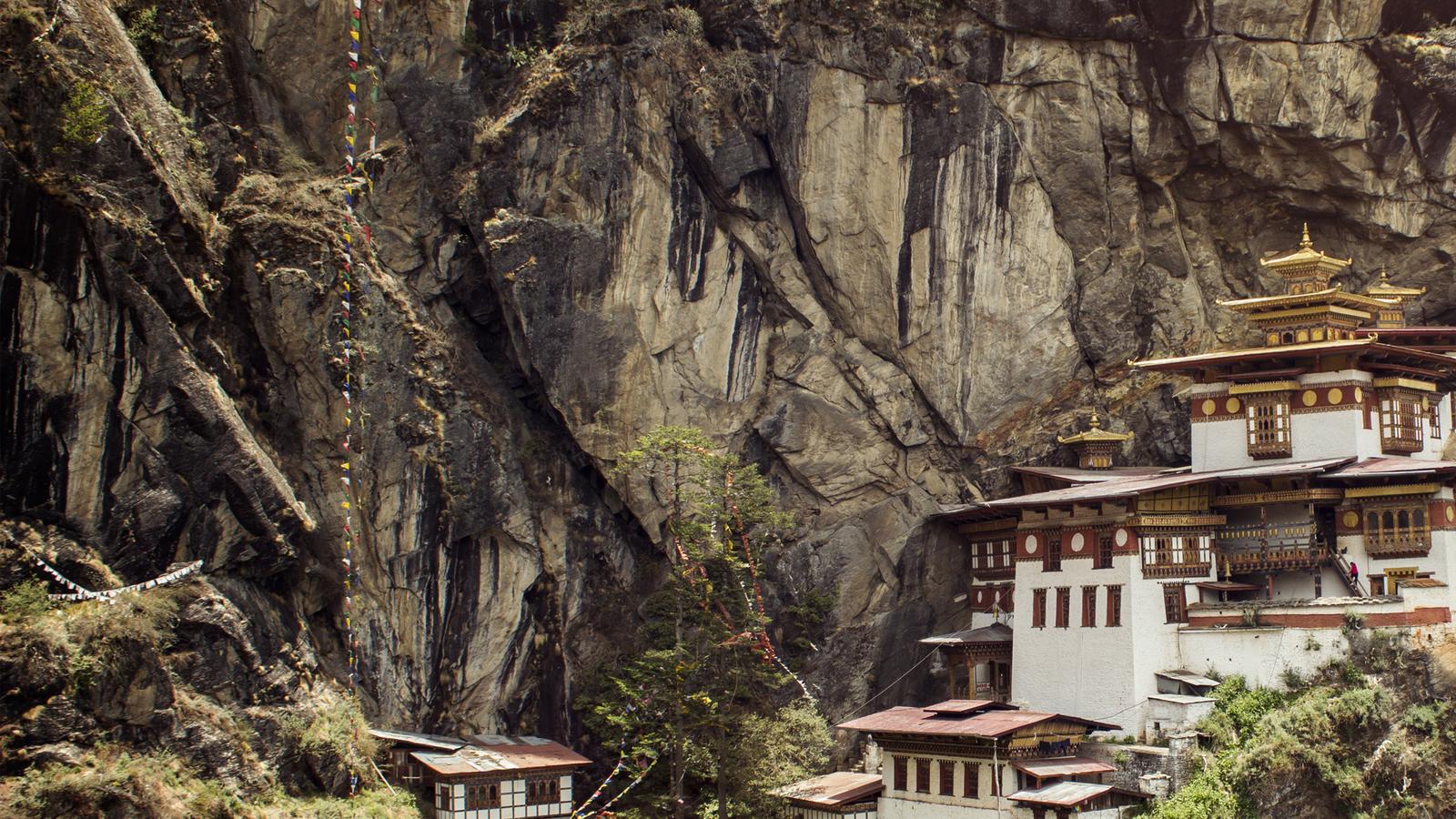Camp the Trans Bhutan Trail
Duration: 11 days
Begins: Paro
Ends: Paro
Trip Code: ADTC
From
£2,999 per person
Overview
- Your Welcome Moment: Arrival Day and Welcome Meeting, Thimphu
- Your Local Living Moment: Bhutanese Homestay
- Arrival transfer
- Sustainable Development Fees
- Visits to Buddha Point and Memorial Chorten
- Full day hiking the Trans Bhutan Trail from Pelela to Chendebi
- Hike along the Trans Bhutan Trail from Chendebi to Tsangkha
- Local farmhouse lunch
- Full day on the Trans Bhutan Trail from Tsangkha to Trongsa
- Tour of the Trongsa Dzong and National Heritage Museum
- Full day on the Trans Bhutan Trail from Trongsa to Gyetsa
- Full day on the Trans Bhutan Trail Gyetsa to Bumthang
- Visit Jakar Dzong (fortress)
- Bhutanese Homestay in Bumthang and Punakha
- Punakha Dzong Visit
- Ta Dzong National Museum visit
- Paro Rinpung Dzong (fortress) visit
- Paro’s Ta Dzong visit
- Taktsang (Tiger’s Nest) Monastery Hike
- Departure transfer
- All transportation between included activities
Hotels (5 nts), homestays (2nts), camping with facilities (3 nts).
10 breakfasts, 10 lunches, 10 dinners
Private vehicle, walking.
CEO (Chief Experience Officer) throughout, local guides.
Full Itinerary
Departure Dates
Day 1 : Paro/Thimphu
After arriving in Paro enjoy an included transfer to your hotel in Thimphu where you will meet the rest of the group and your local tour leader. If time permits, head out in the afternoon to Buddha Point, home to Thimphu’s most recognized landmark, the Buddha Dordenma. Then, visit the Memorial Chorten, a Tibetan-style stupa built in 1974 and one of Thimphu’s most impressive religious sites. This evening gather as a group at a local restaurant for a welcome dinner and your first chance to sample Bhutanese cuisine.
With elevations ranging between 2,248 meters (7,375 feet) and 2,648 meters (8,688 feet) above sea level, Thimphu is the fifth highest capital city in the world by altitude. It is also the only capital city in the world without any traffic lights. The city offers a unique blend of the modern world with Bhutanese tradition.
In order to have time for a visit to Buddha Point please plan to get to Bhutan by noon so that you can reach Thimpu by late afternoon and have enough time to do an orientation before going to Buddha Point. Most flights arrive to Paro in the morning.
Airport Transfer
Arrival Day and Welcome Meeting
The adventure begins today. Meet fellow travellers and learn more details about the upcoming itinerary from the CEO during today's meeting.
Buddha Point Visit
Buddha Point is home to Thimphu’s most recognized landmark, the Buddha Dordenma. Guarding the entry to the Thimphu valley, this 51-meter (167ft) gilded bronze statue is filled with 125,000 miniature statues and sits atop a three-storey base housing a chapel and thousands of donated statuettes. The statue was commissioned to mark His Majesty the Fourth King of Bhutan, Jigme Singye Wangchuck’s 60th birthday and was originally made in China before being transported to Thimphu in pieces. The massive Buddha statue in Thimphu made of bronze and gold. Take lots of pictures - it's beautiful!
Memorial Chorten Visit
The chorten is one of the most prominent religious structures in Thimphu, and for local Bhutanese it is a popular part of their daily prayers. Watch locals walk around the Chorten, spinning the prayer wheels and meditating in this lovely and peaceful spot.
Bhutanese Group Dinner
Head out with the group to enjoy dinner at a local restaurant where you'll have your first chance to learn about and sample Bhutanese cuisine.
Acommodation
Hotel Kisa Villa
Acommodation
Hotel Kisa Villa
Lunch | Dinner
Day 2 : Thimphu/Chendebi
Today will be your first day trekking on the Trans Bhutan Trail. The group will transfer eastwards to Pelela for the start of the hike at 3,407 metres (11,177 feet) above sea level. As you descend through the meadows below Pelela, keep an eye out for the yak herder camps which can be seen scattered around the valley. For lunch you’ll stop in at a traditional farmhouse in the village of Rukubji to enjoy a hot lunch, before visiting Rukubji’s village Lhakhang (temple), also known as Kuenzang Choling. Rukubji is also famous for its unique local language, and you will have the chance to learn about it from the villagers over tea.
After lunch, rejoin the trail for a gentle climb out of the valley, through the forest, and back down to the village of Chendebi, where the group will camp for the night. Once there, visit the Chorten (stupa), which is believed to have been built on the point on which the three ridges and the three edges of the sky meet. A delicious organic, locally sourced dinner will be served at the campsite in the evening.
This ancient route, which runs 403 kilometres from Haa in the West of Bhutan to Trashigang in the East, dates back at least as far as the 16th century, when it would have been the only means of communication between the strategically located dzongs (fortresses) along the route. The Trail’s Garps (messengers) were quite legendary, travelling with vital messages between Dzongs at great speeds with little food or rest. Over time, the Trail came to play a major role in uniting the region’s many kingdoms, culminating in the birth of Bhutan as a nation in 1907. With the advent of Bhutan’s National Highway in the 1960s, the Trail fell into disrepair but was restored in 2019 thanks to a partnership between the Royal Bhutanese Government, the Tourism Council of Bhutan, and the Bhutan Canada Foundation. The Trail now receives visitors from across Bhutan and the world. When stopping the the village of Rukubji learn more about the local language from the locals. The dialect, called Ngyen-Kye, is a mix of other dialects from across Bhutan and even some English words, and is now only spoken by a dozen or so households.
During the hiking portion of this trip the Trans Bhutan Trail Team will be carrying any additional belongings that travellers have with them from location to location. You will only need to worry about carrying your day pack. There isn't a specific weight limit for luggage, but keep in mind that someone will be carrying it for you along the trail. There will be a vehicle carrying the big bags to sites. Bottled water will be supplied through out the trek.
Private Vehicle
Enjoy the scenery of you private vehicle towards Pelela, where you will rejoin the Trans Bhutan Trail to hike the rest of the way to Chendebi.
Pelela Pass Segment of the Trans Bhutan Trail
At 3,407 metres (11,177 feet) above sea level, the Pelela Pass is one of Bhutan’s highest and is traditionally considered to mark the boundary between west and central Bhutan. Local craftspeople often sell fine yak-hair products at the pass. As you descend through the meadows below Pelela, keep an eye out for the yak herder camps which can be seen scattered around the valley. The group will hike from 3320m to 2425m and it will take about 4 hours to complete with a total hiking distance of 11 km (6.8 mi).
Rukubji’s village Lhakhang (temple) Visit
Rukubji’s village Lhakhang also known as Kuenzang Choling, is thought to have been built some 300 years ago by a Lama named Tshendhen Duelwa. Unlike most temples, it is not built on a ridge with a view out over a valley, but rather on an extended plateau and close to two rivers: the reason for this is that the Lama built the temple on top of the head of a snake-demoness which he subdued in the same location.
Chorten (stupa) Visit in Chendebi
At Chendebji, visit the Chorten (stupa), which is built at on the point on which it is believed that the three ridges and the three edges of the sky meet. The Chorten was built by Lam Ngedup Tshering Wangchuk in order to subdue a local demoness, Nyala Dudm, and bring peace to the Chendebji Valley.
Acommodation
Camp Chandebji
Acommodation
Camp Chandebji
Breakfast | Lunch | Dinner
Day 3 : Chendebi/Tsangkha
Eat breakfast at your camp before rejoining the Trans Bhutan trail at the Chendebi Chorten (stupa). Follow the trail along the old East-West National Highway and then trek back into the countryside towards the village of Tangsibji. Fill those stomachs with a farmhouse lunch in the village before continuing further along the trail passing several hydroelectric project sites. These clean, renewable energy projects are one of the ways in which Bhutan has achieved its status as the only carbon negative country in the world. In the afternoon, visit the Trashi Choeling Lhakhang (temple), located in Trashiling village. Once the group arrives in Tsangkha you will visit the Tshangkha Lhakhang (temple) before heading to your campsite where you will enjoy a hot shower and a locally-sourced organic dinner with the group.
On days when you will be hiking it’s recommended that you have your own day pack to carry during the long hiking days. In the pack you should have any daily, personal medicine you may need, sunscreen, cameras, a water bottle, and any valuables such as cash or passports.
During the trekking itself the camping crew will provide all travellers with boiled water. You can fill your water bottles with this water provided during the hiking days. But it is highly recommended that you bring your own water bottles.
Trashi Choeling Lhakhang (temple)
Trashi Choeling Lhakhang (temple) is located in Trashiling village The temple was built in 2002 as an offering to His Majesty the Fourth King of Bhutan by His Holiness the 70th Je Khenpo.
Tshangkha Lhakhang (temple) Visit
The ground on which the temple stands is thought to have been first blessed on an unknown date by Lopen Golay of Tshangkha, who gained his wisdom and power from the mantras of the Mindroling monastery in Tibet. The first structure was built here in 1701 by Choezang, who served as the Trongsa Chamberlain, and the site now provides a venue for both social and religious community gatherings.
Trans Bhutan Trail Chendebi to Tsangkha
Along the Trans Bhutan Trail between Chendebi to Tsangkha you will follow the old East-West National Highway for a short while, before heading back deep into the countryside towards the village of Tangsibji. A hot lunch will be served at a farmhouse in Tansibji. Today, the Trail route passes the sites of several hydroelectric projects. These clean, renewable energy projects are one of the ways in which Bhutan has achieved its status as the only carbon negative country in the world. Bhutan also exports large amounts of green energy to neighbouring India. The group will hike from 2425m to 2276m and it will take about 8 hours total with a final hiking distance of 21 km.
Acommodation
Camp Tsangkha
Acommodation
Camp Tsangkha
Breakfast | Lunch | Dinner
Day 4 : Tsangkha/Trongsa
Head back to the Trans Bhutan Trail after breakfast at your camp. Today’s trek includes a short, but steep climb out of Tsangkha passing the Ugyen Choling and Tsangkha Sheydra. Then, the trail drops back down to cross the National Highway at the Trongsa viewpoint which is considered to be the geographical center point of Bhutan. Recreate the experience of past royals as you descend as a group into the steep valley below. See spectacular views of the Dzong (fortress) and cross the old cantilever bridge over the Mangde River before climbing the other side of the valley to reach Trongsa Dzong via the Western gate. After arriving to our hotel, the rest of the day is yours to relax and explore before joining back together for dinner at a local restaurant in the early evening.
Trongsa is Bhutan’s geographical center point and is very closely linked to the Bhutanese Royal Family: the first two hereditary Kings ruled from Trongsa Dzong (fortress) and the crown prince still traditionally serves as the Penlop (Governor) of Trongsa before acceding to the throne. The Trans Bhutan Trail still passes directly through the middle of the city of Trongsa and, in centuries gone by, the trail would actually have passed right through Trongsa Dzong itself.
On days when you will be hiking it’s recommended that you have your own day pack to carry during the long hiking days. In the pack you should have any daily, personal medicine you may need, sunscreen, cameras, a water bottle, and any valuables such as cash or passports.
During the trekking itself the camping crew will provide all travellers with boiled water. You can fill your water bottles with this water provided during the hiking days. But it is highly recommended that you bring your own water bottles.
Trans Bhutan Trail Tsangkha to Trongsa
This section of the Trans Bhutan Trail between Tsangkha and Trongsa includeds a short, steep climb out of Tsangkha, past the Ugyen Choling and Tsangkha Sheydra. The Trail then drops back down towards the National Highway, which it crosses at the Trongsa viewpoint. Trongsa is Bhutan’s geographical center point and is very closely linked to the Bhutanese Royal Family: the first two hereditary Kings ruled from Trongsa Dzong (fortress) and the crown prince still traditionally serves as the Penlop (Governor) of Trongsa before acceding to the throne. The Trans Bhutan Trail still passes directly through the middle of the city of Trongsa and, in centuries gone by, the trail would actually have passed right through Trongsa Dzong itself. Today you will recreate the experience of arriving at this powerful city on foot in the same way the garps (messengers) would have done centuries ago, as you descend into the steep valley below the viewpoint, enjoying spectacular views of the Dzong (fortress) on the opposite side. At the bottom of the valley, you will cross the old cantilever bridge over the Mangde River before heading up the other side of the valley and entering Trongsa Dzong (fortress) via the Western gate. The group will hike from 2276m to 2200m and it will take about 5 hours total with a final hiking distance of 16 km.
Acommodation
Yangkhil Resort
Acommodation
Yangkhil Resort
Breakfast | Lunch | Dinner
Day 5 : Trongsa
Devour a quick breakfast this morning before heading out for a tour of Trongsa Dzong (fortress), first built as a small meditation room in 1541. Visit a selection of the Dzong’s 23 lhakhangs (temples), before heading to the Trongsa Ta Dzong (watchtower), which now houses the interesting Royal Heritage Museum. The remainder of the day will be at leisure to explore Trongsa at your own pace.
Trongsa Dzong (fortress) Visit
Trongsa Dzong (fortress) was first built by Ngagi Wangchuck as a small meditation room in 1541, after he discovered self-manifested hoof-prints belonging to the deity Pelden Lhamo on the same spot. Trongsa, which means ‘new village’ in the local dialect, soon spring up around the site. The Dzong (fortress) was built in its present form in 1644 and then enlarged again at the end of the 17th century. It is home to some 450 district monks who spend their winters in Trongsa and their summers in Bumthang.
Free time:
Spend the rest of your time here exploring Trongsa at your own pace.
Acommodation
Yangkhil Resort
Acommodation
Yangkhil Resort
Breakfast | Lunch | Dinner
Day 6 : Trongsa/Gyetsa
Wave farewell to Trongsa today and head back out on the Trail for some more hiking. The trail between Trongsa and Gyetsa begins with a gradual climb upwards to Kewathang. Trek through a stretch of dense forest as the group continues through Yotongla where you’ll stop to enjoy a picnic lunch. Cross through meadows and through open forest until the trail reaches the Gyetsa River. Once the group arrives at camp in Gyetsa you’ll be able to enjoy a hot shower and a locally-sourced organic dinner at the campsite.
On days when you will be hiking it’s recommended that you have your own day pack to carry during the long hiking days. In the pack you should have any daily, personal medicine you may need, sunscreen, cameras, a water bottle, and any valuables such as cash or passports.
During the trekking itself the camping crew will provide all travellers with boiled water. You can fill your water bottles with this water provided during the hiking days. But it is highly recommended that you bring your own water bottles.
Trans Bhutan Trail Trongsa to Gyetsa
Today’s portion of the Trail begins with a gradual climb up towards Kewathang. Today’s trek crosses a number of ecological zones and so is particularly rewarding for birdwatchers. From Kewathang, the Trail cuts through dense forest until it reaches the pass at Yotongla. Enjoy a picnic lunch en route. From Yotongla, the Trail descends through meadows and open forest until it meets the Gyetsa River. The last stretch for today is a pleasant riverside walk towards Gyetsa. The group will hike from 3425m at Yotong La Pass to 2891m and will take at least 4 hours for a total distance of 9.5 km.
Acommodation
Camp Gyetsa
Acommodation
Camp Gyetsa
Breakfast | Lunch | Dinner
Day 7 : Gyetsa to Bumthang
Today after breakfast the group will trek through the most historic section of the trail. This section was used by the royal family when they travelled between their winter and summer residences. You’ll travel through Kikila Pass before descending into the Bumthang Valley. We’ll stop along the way for a picnic lunch, enjoying the scenery.
Once you arrive in Bumthang, visit the majestic Jakar Dzong (fortress), also known as the ‘Castle of the White Bird’. Observe unique features like its fifty-meter utse (tower) and a sheltered passage with two parallel walls, interconnected by fortified towers, which guaranteed the fortress’s inhabitants access to water during a siege. This evening, enjoy a special experience as you settle into your local homestay accommodation. Spend the evening with a few of your fellow travelers in the home of a local Bhutanese family who will be your hosts for the evening. Share a meal and exchange stories while learning about what life is like for your local hosts.
On days when you will be hiking it’s recommended that you have your own day pack to carry during the long hiking days. In the pack you should have any daily, personal medicine you may need, sunscreen, cameras, a water bottle, and any valuables such as cash or passports.
During the trekking itself the camping crew will provide all travellers with boiled water. You can fill your water bottles with this water provided during the hiking days. But it is highly recommended that you bring your own water bottles.
Bhutanese Homestay
Settle into your local homestay accommodation. Spend the evening with a few of your fellow travellers in the home of a local Bhutanese family who will be your hosts for the evening. Share a meal and exchange stories while learning about what life is like for your local hosts. Because of group size three rooms in each home will be available and the group will be separated between those rooms.
When staying with a local family in a homestay or farm stay the accommodation is very simple and basic, but clean. Each room can accommodate around 2 or 3 group members at a time. Depending on the community or village the group stays with, each property will have 2 or 3 rooms designated as guest accommodation. Meals during the stay are cooked by the family members of the home and shared with the guests. Meals will consist of local meats and locally grown vegetables from the host family or community. Guests will sit down with their host families to enjoy the meal at a dining table. In Bhutan it is customary to sit on a low chair or the floor for meals, there may not be any normal sized chairs. All homestay properties include shared bathrooms which are European style and clean. Shower facilities are also available during homestays and farmstays.
Jakar Dzong (fortress) Visit
Jakar Dzong (fortress), is also known as the ‘Castle of the White Bird’. This huge structure dominates the Chamkar Valley and the town below it. It was built in 1549 by the Tibetan Lam Nagi Wangchuk and was Eastern Bhutan’s main defensive stronghold. Later, it became the seat of the First King of Bhutan. Unique features include its fifty-meter utse (tower) and a sheltered passage with two parallel walls, interconnected by fortified towers, which guaranteed the fortress’s inhabitants access to water during a siege.
Trans Bhutan Trail Gyetsa to Bumthang
Trek through the most historic section of the trail which the royal family used when they travelled between their winter and summer residences. The trail passes through the Kikila Pass and the owl trek and then gently descends into the Bumthang Valley. The group will hike from 2891m to 2574m and it should take about 7 hours for a total distance of 17.5 km.
Acommodation
Bumthang Homestay
Acommodation
Bumthang Homestay
Breakfast | Lunch | Dinner
Day 8 : Bumthang to Punākha
Enjoy breakfast at your homestay before transferring back to the charming town of Punakha for a day of exploring. You’ll stop for lunch en route and then visit the Bazam (bridge) just across the river from Punakha Dzong (fortress). In order to cross the bridge on foot you must be wearing formal Bhutanese dress, including a gho for men and a kora for women. On the other side head out on a tour of the Dzong (fortress).
In the evening, enjoy another homestay experience with local Bhutanese families. Tuck into a delicious homemade meal and rest up for another incredible day ahead
Private Vehicle
Settle in and scan the scenery from the convenience of a private vehicle.
Punakha Dzong Visit
Visit Punakha Dzong, the winter seat of the Je Khenpo and the Monk Body, remarkably located between the rivers of the Mo (female) Chu and Pho (male) Chu. It is the second oldest and second largest dzong (fortress) in Bhutan and one of its most majestic structures, housing many sacred relics. It is also the winter capital of the Je Khenpo (chief abbot). Built by Zhabdrung Ngawang Namgyal in around 1637. Arguably, it is the most beautiful Dzong in the country. The Dzong guards Bhutan’s most treasured relic, the Rangjung Kharsapani, an image of Chenresig kept away from the public in the utse (tower). It has survived Tibetan invasions, numerous fires, floods and a glacial lake burst. The Dzong served as the capital and seat of the Bhutanese Government until the early 1950s; and the coronation of the His Majesty the First Druk, Gyalpo Ugyen Wangchuck, took place here.
Bhutanese Homestay
Settle into your local homestay accommodation. Spend the evening with a few of your fellow travellers in the home of a local Bhutanese family who will be your hosts for the evening. Share a meal and exchange stories while learning about what life is like for your local hosts. Because of group size three rooms in each home will be available and the group will be separated between those rooms.
When staying with a local family in a homestay or farm stay the accommodation is very simple and basic, but clean. Each room can accommodate around 2 or 3 group members at a time. Depending on the community or village the group stays with, each property will have 2 or 3 rooms designated as guest accommodation. Meals during the stay are cooked by the family members of the home and shared with the guests. Meals will consist of local meats and locally grown vegetables from the host family or community. Guests will sit down with their host families to enjoy the meal at a dining table. In Bhutan it is customary to sit on a low chair or the floor for meals, there may not be any normal sized chairs. All homestay properties include shared bathrooms which are European style and clean. Shower facilities are also available during homestays and farmstays.
Acommodation
Punakha Homestay
Acommodation
Punakha Homestay
Breakfast | Lunch | Dinner
Day 9 : Punākha/Paro
Today after breakfast, the group will transfer to Paro where you’ll check into the hotel and have lunch. Then , it’s time to head out and see some of Paro’s most popular sites. Visit the Ta Dzong or ‘watchtower’ which is now Bhutan’s National Museum, home to a number of exhibitions including sculpture, painting and artifacts depicting Bhutan’s magical past. Then, continue to the stunning Paro Rinpung Dzong (fortress), meaning ‘Fortress on a Heap of Jewels’, This evening indulge in some delicious dinner with your CEO and fellow travellers.
Private Vehicle
Settle in and scan the scenery from the convenience of a private vehicle.
Ta Dzong National Museum
The National Museum of Bhutan houses an extensive collection of Bhutanese art, with pieces dating back for centuries.
Paro Rinpung Dzong (fortress) Visit
Paro Rinpung Dzong (fortress), meaning ‘Fortress on a Heap of Jewels”. The original construction of this dzong is believed to have been completed in 1458 and it was restored to its present glory by His Majesty the Third of Bhutan, King Jigme Dorji Wangchuck, to mark his royal wedding in 1951.
Paro’s Ta Dzong Visit
Paro’s Ta Dzong or ‘watchtower’ was originally built in 1649 to protect Paro Dzong from the Tibetan military. In 1968, Ta Dzong became Bhutan’s National Museum, and is now home to a number of exhibitions including sculpture, painting and artifacts depicting Bhutan’s magical past.
Acommodation
Metta Resort
Acommodation
Metta Resort
Breakfast | Lunch | Dinner
Day 10 : Paro
Fill up on breakfast before heading northwest out of Paro for a visit to the iconic Taktshang Goemba, more commonly known as the ‘Tiger’s Nest Monastery’. Precariously perched on a sheer cliff face 900 metres (2,950 feet) above the Paro Valley floor, the Tiger’s Nest is undoubtedly Bhutan’s most famous religious building. The trek offers spectacular views from the ridge and passes a small chorten, a basic monastery, and a waterfall on its way. Once you have reached the Tiger’s Nest, you will have a chance to visit the cave where Guru Rinpoche meditated, as well as the extensive network of Lhakhangs (chapels) which house images, murals, chortens, and a holy spring.
If time allows, make a quick trip to Machig-phu Lhakhang (temple) on the way back down to the access road. The rest of the afternoon will be at leisure to relax at your hotel or to explore Paro on your own, before enjoying a last dinner with your group at a local restaurant to celebrate the trip!
Free time:
Spend the afternoon and early evening exploring Paro on your last full day in this Bhutanese city.
Transport
Settle in and scan the scenery as you journey to and from the Tiger’s Nest Monastery Hike from Paro.
Taktsang (Tiger’s Nest) Monastery Hike
Hike up to the Taktsang monastery (Tiger’s Nest); containing 13 holy relics, it's considered one of the most venerated pilgrim sites of the Himalayan world. It is also where Guru Padmasambhava is said to have landed on the back of a tigress in the 8th century. Take in the stunning views en route and the incredible vista from this monastery, which clings to the rock towering 2,953m above the valley. The group will hike from 2400m elevation and reach 3100m at the Taktsang Monastery before returning back to 2400m in the same day. The climb should take around 6 hours for a total distance of 7 km.
Acommodation
Metta Resort
Acommodation
Metta Resort
Breakfast | Lunch | Dinner
Day 11 : Paro
Enjoy one last breakfast before being transferred from your hotel to the airport for your flight home.
Departure Transfer
You will be met at your hotel and transferred to the airport at the end of your adventure.
Breakfast
| dates start-End | Availability remaining spaces | Price Per Person | |
|---|---|---|---|
| Aug 2025 | |||
| Sun, 31 Aug - Wed, 10 Sep | 7+ available | £2,999 | Request a quote |
| Sep 2025 | |||
| Sun, 14 Sep - Wed, 24 Sep | 4 available | £3,299 | Request a quote |
| Sun, 28 Sep - Wed, 08 Oct | 1 available | £3,299 | Request a quote |
| Oct 2025 | |||
| Sun, 12 Oct - Wed, 22 Oct | Sold out | ||
| Apr 2026 | |||
| Sun, 05 Apr - Wed, 15 Apr | 7+ available | £3,299 | Request a quote |
| Sun, 12 Apr - Wed, 22 Apr | 7+ available | £3,299 | Request a quote |
| Sun, 19 Apr - Wed, 29 Apr | 7+ available | £3,299 | Request a quote |
| Sun, 26 Apr - Wed, 06 May | 7+ available | £3,299 | Request a quote |
| May 2026 | |||
| Sun, 03 May - Wed, 13 May | 7+ available | £3,299 | Request a quote |
| Sun, 10 May - Wed, 20 May | 7+ available | £3,299 | Request a quote |
| Sun, 17 May - Wed, 27 May | 7+ available | £3,299 | Request a quote |
| Sun, 24 May - Wed, 03 Jun | 7+ available | £3,299 | Request a quote |
| Sun, 31 May - Wed, 10 Jun | 7+ available | £3,299 | Request a quote |
| Jun 2026 | |||
| Sun, 14 Jun - Wed, 24 Jun | 7+ available | £3,099 | Request a quote |
| Jul 2026 | |||
| Sun, 12 Jul - Wed, 22 Jul | 7+ available | £3,099 | Request a quote |
| Aug 2026 | |||
| Sun, 09 Aug - Wed, 19 Aug | 7+ available | £3,099 | Request a quote |
| Sun, 30 Aug - Wed, 09 Sep | 7+ available | £3,099 | Request a quote |
| Sep 2026 | |||
| Sun, 13 Sep - Wed, 23 Sep | 7+ available | £3,299 | Request a quote |
| Sun, 27 Sep - Wed, 07 Oct | 7+ available | £3,299 | Request a quote |
| Oct 2026 | |||
| Sun, 11 Oct - Wed, 21 Oct | 7+ available | £3,299 | Request a quote |

